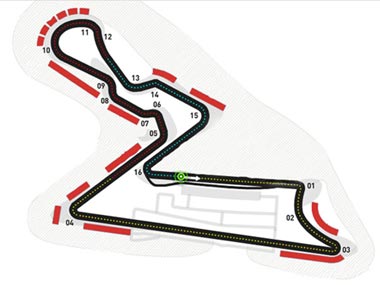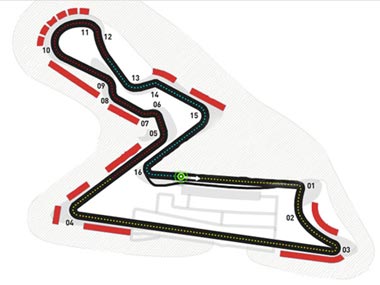Formula One returns to the Buddh International Circuit for the third edition of the Indian Grand Prix. The track, located on the outskirts of capital New Delhi, features several elevation changes and a variation of long straights, tight hairpins and high-speed changes of direction. The circuit, the second fastest on the calendar after the legendary Monza, has won high praise from drivers who have compared the layout to such historic venues as Spa and Suzuka. Here we take a look at some of the track statistics before embarking on a flying lap of the circuit. Track Statistics Laps – 60 Track length – 5.125 km Race first held – 2011 Most wins – Sebastian Vettel (2011, 2012) 2012 pole position – Sebastian Vettel (1:25.283) 2012 race winner – Sebastian Vettel A flying lap of the Buddh International Circuit The lap begins in the shadow of the massive grandstand whose roof extends out over the start-finish straight. The run down the home straight to turn one is relatively short. Move over to the left of the track to take your line for Turn 1, brake as late as possible down to third gear before turning into the right-hander. The track appears to open up a bit at the exit of Turn 1 and its width and the ample amounts of run-off available make it very tempting to get on the power early as you hit the apex of Turn 1. [caption id=“attachment_1187033” align=“alignleft” width=“380”]  Buddh International Circuit.[/caption] But the track turns back in on itself just before swerving to the left again through the Turn 2 kink and being too greedy on the throttle will see you out over the run-off, scrabbling for grip on the dusty surface, having to come off the throttle to find your line again. You keep the throttle floored as you head up the hill through the left handed kink that is Turn 2, shifting up through the gears before slamming on the anchors for the extremely tight Turn 3, the slowest corner on the circuit. The approach to Turn 3, at the crest of the hill, is blind and there are several different lines through the corner. Lock-ups into this corner are common and you can see several drivers smoking their tyres and missing the apex in practice as they experiment with the various lines through the corner, some preferring a late turn in after having slowed the car down while others turn in early on the brakes. Again, the width of the track here can be deceptive and you have to be patient on the throttle, the engine note wavering as you feather the pedal searching for traction, before eventually flooring it down the long, long straight. This is the most crucial exit of all on the circuit and you have to get it just right as it will determine how much speed you carry and, as a result, how much time you gain or lose as you head down the long straight that follows. The cars reach a top speed of about 320 kilometers an hour at the end of the straight before having to brake hard for the tight Turn 4. This is a good overtaking opportunity and any driver that has been passed at Turn 3 can get his own back under braking for Turn 4, provided he gets a good exit out of three and uses the slipstream well. However, with the cars traveling as fast as they are, finding and hitting the right braking point for Turn 4 is extremely tricky, made all the more so by the track starting to fall away down the hill just as you begin to brake for the corner. The turn in into the corner is also extremely challenging and you have to really work the car into the apex, fighting the off-camber entry which keeps trying to push the car out wide. Again, it’s important to carry as much speed as you can through the corner, running the car out over the exit kerb, down another short straight stretch which takes you into a series of technically demanding corners and high-speed changes of direction. Good stability is key through this section of corners – a double left hander followed by two quick chicanes – and there is a lot of time a driver can gain through here by setting the car up correctly to generate just enough downforce and rear end grip, allowing him to carry as much speed as possible through this extremely technical section, without giving too much away on the straights. A car like the Red Bull, with good rear end stability, which looks like it is on rails and allows a driver to keep working the throttle throughout this section will shine through here. Next up is the Turns 10, 11 and 12 complex, probably the circuit’s most distinguishable feature, which is basically one long right hander with multiple apexes that sees the track double back on itself. It’s important to keep your speed up all the way through this corner, applying a burst of throttle mid-corner but having the discipline to get off the power to get the car to turn in to clip the second apex. The track starts to climb again as you exit the corner, swinging all the way across to the right hand side to get your line for the first part of another quick chicane which takes you to the crest of the hill, the circuit now heading back towards the pits. Again at the exit, run the car out over the kerbs before shifting down two gears to third for the downhill Turn 15. You’re soon on the throttle for the short burst down to the final corner, before slowing the car down to a little under a 100 kilometers per hour, all the while careful not to lock the brakes. This corner is again deceptively tight, inviting you to get onto the power early, but it’s important to be patient and gentle on the throttle so as not to ruin your lap at the very end as you exit the corner to cross the line.
The circuit, the second fastest on the calendar after the legendary Monza, has won high praise from drivers who have compared the layout to such historic venues as Spa and Suzuka.
Abhishek has only one passion in life. Formula One. He watched his first race on television way back in the mid-nineties with his father and since then has been absolutely hooked. In his early teens, he harboured dreams of racing in the top flight of motorsport, fighting wheel-to-wheel with the likes of Schumacher, Hill and Hakkinen but when it became evident that he didn't quite have the talent to cut it in go karts, let alone Formula One, he decided to do the next best thing - write about the sport. Abhishek is happiest when there's a race on television or when he's indulging in his F1 fantasies on the PlayStation. see more


)

)
)
)
)
)
)
)
)



